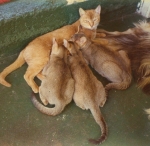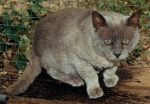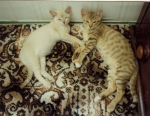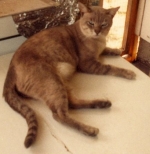by Truda M Straede BSc PhD
THE BREED FOUNDER
EARLY DAYS
THE IDEA


Kempala Leo

1) Burmese dilute and colours brown, blue, chocolate and lilac, to come from Burmese.
2) Ticking (agouti) gene necessary to develop the tabby pattern to come from the Aby.
3) The tabby (spotted) pattern to come from:
a) ghost spotted Burmese b) well spotted domestics.
Even at this early stage, my application included the big round head from Beren, and his "lion cub" muzzle, but with good Burmese ears, positioned as in the Burmese, green to aquamarine eyes, and a double coat (from the Abys) with a good thick tail.
Needless to say, this was all too much for the RASCC Consultative Committee. On the 7th June 1977 they gave me "provisional permission to experiment" - expecting that this would be the last they heard of the matter, but they had given me at least the skeleton of the rules by which I was to operate.
My first mating Leo, (Brown Burmese) x Nepy (Cinnamon Aby) produced "usual" Abys of which Balkis was kept. She arranged her own first litter. Her second official mating to Beren (Lilac Burmese) produced (28.8.79) a lovely and useful litter including a Chocolate Tabby (Clovis), a Chocolate 'Aby', a Chocolate Burmese and a Chocolate Tabby Burmese, dilute Aby (Naia). The latter combination I dubbed "Aburmese". and I bred several during the programme. They have the Aby pattern but in the Burmese colours and they are very pretty. (One appeared in TV ads from time to time, with Bronson). Of course, you will have perceived that no Spotted Mist was born, though just about every other possibility was! Clovis had the most stunning "lion cub" head, but from totally Aby and Burmese ancestry he had every white fault in book - white toes, white locket, white groin and armpit spots, white "bat wing" mark on chest mid-line. These, I believe, nearly cost me my permission when I took the kittens to the committee for approval. Naia had no white faults, and was also lovely in type.

Clovis & Naia - note his white toes .....

I am not, of course, going to go through every mating, blow by blow, but I must mention some of the efforts made to obtain new bloodlines.
Mick Patterson, owner of New Zealand Champion Pettsbush Jannu (Lilac Burmese) very kindly allowed me to use this new bloodline, free of charge but try as we might, we could only get Aby pattern kittens. Presumably Jannu was homozygous for this (desirable in Burmese) characteristic - so Mick in fact got rather more use out of these matings than I!
Early in 1987 I had a real break, when Julie Mavros, who had seen some of my early generations at shows, became enthusiastic about the breed, and found a foundation kitten - Blue, and superbly spotted all over with big coin spots. Julie found she couldn't really cope with a stud, so Zetes became mine when about 14 weeks old. From him came the purest, most desired of spot patterns. Regrettably he sired very few kittens, being accidentally let out and failing to return from the bush when only 18 months old.
Elf

Horatio

Zetes

(The 1 in 64 chance, Woozle)
Frith produced several litters, to Burmese boys, of lovely Tonkinese/Burmese pattern kittens with and without white, which I sold/gave away as pets - and a black and white litter, which I definitely gave away. Having worked out her probable genotype, and what I would get if I mated her to Clovis, I decided to try it. I knew that I had only a 1/64 chance of producing a Spotted Mist Kitten. On June 8th 1981, you can imagine my disbelief when she produced her litter of one Burmese Brown, one Blue Tabby, one Blue with White toes, locket and mid-line spot, one Blue and one BLUE SPOTTED MIST. At least, I thought it was Lilac originally, but changed my mind before he was grown. He certainly wasn't Tonkinese pattern, (none of them were) and he was beautifully spotted. As he grew up, he also developed aquamarine eyes.
In July 1981 I applied to the RASCC to include Frith as foundation stock; just for this one kitten, I hasten to add. I then had to supply lots more information as the committee was concerned that "Siamese type seems inimical to the type described in your provisional standard". So it is, but Frith was from domestic and Burmese stock; and that "The presence of white spotting in a cat of Siamese pattern (parent generation) would appear to be a genetic fault in the original (unknown) Siamese stock, and as such might prove a serious danger to the programme. The appearance of white-toed kittens in the first litter would confirm this danger".
As any of you who have met the monumental Clovis cat, and re-read the first part of the article will realise, the white faults I described in the Frith x Clovis litter do not correspond with Frith's pattern, but Clovis' faults. I was also able to reassure the RASCC on this point, because Frith had already had to Burmese sires either full coloured no white spots kittens (12) or bi-colours, with substantially the same white pattern as herself (12).
The RASCC finally concurred on 23rd September 1981, that "Woozle" could be registered, but expressed concern about the introduction of more domestic bloodlines by other breeders now registered to join the programme.
You will notice that a couple of other prefixes (Chamati, Zhona) appear in the Gen 1 list, which means of course, that they were officially members of the programme. Behind many a "Nintu" there also stands another breeder, to many of whom I am very grateful for having provided a loving home for a female kitten, having the odd litter or two, and widening the circle of interest in the breed through the sale of kittens. This is to say nothing of their role in keeping options open, and providing some protection for the breeding stock by not having them all under one roof. I was more than grateful for this when the FeLv epidemic I suffered in 1987 looked likely to decimate my own stock.

Woozle as a baby

Woozle as an adult, showing 'overmasking'

The Experimental Years
Virginia Weekes (Chamati) stayed with the programme for a few years and contributed Nintu Myrddin (from a Chamati queen), and then worked with Bette Diver (Zhona). Bette Diver bred some beautiful litters and found 'Just Fred' as foundation stock; however, she withdrew when she found that she had Feline Leukaemia and in fact stopped breeding cats altogether. She was a great loss as she was full of enthusiasm for the breed and a great publicist at Shows around the Newcastle area. I took some of her stock (tested FeLv free - at least according to the tests available at the time) and from Zhona Wynella and Zhona Adric I bred Nintu Balin, thus conserving something from 'Just Fred'.
All the other people who have participated in the programme have been unofficial, Jean Villani, Margaret Chapman, Erin White, The Ellims, the Esdailes, John & Cheryl Straede, Lesley Baker, to name a few. A very hearty thankyou to them for their help. Without them I would not have been able to maintain nearly as many different blood lines.
All this is summarised below ….
Just Fred
